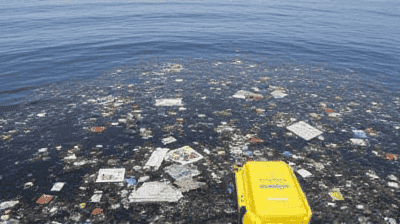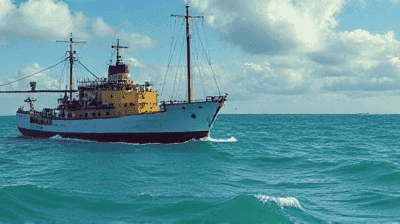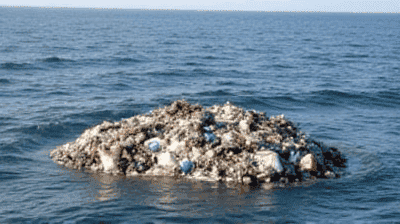
The Great Pacific Garbage Patch is one of the most notorious examples of marine pollution in the world today. Often described as a vast floating island of debris, it raises urgent questions about humanity's impact on the ocean and the effectiveness of cleanup efforts. Covering an area estimated to be twice the size of Texas, the Great Pacific Garbage Patch is primarily composed of plastic waste that has accumulated due to ocean currents. The patch serves as a stark reminder of the consequences of our consumption habits, and it presents significant challenges for marine life and ecosystems.
The Great Pacific Garbage Patch is not a solid mass of trash, as many people imagine. Instead, it is a region of the North Pacific Ocean where high concentrations of microplastics and plastic debris are trapped by ocean currents. This phenomenon is largely attributed to human activities and the dramatic increase in plastic production and consumption over the past decades.
Plastic Production Boom: Since the 1950s, the production of plastic has skyrocketed, resulting in millions of tons entering the market each year. This growth has been driven by the convenience and versatility of plastics in various applications, from packaging to construction.
Disposal Issues: A significant portion of plastic waste is improperly disposed of or not recycled. Many plastics end up in landfills or are discarded inappropriately, eventually making their way into waterways and oceans through rain runoff, rivers, and wind.
Ocean Currents: The North Pacific Gyre, a vast system of ocean currents, plays a crucial role in the accumulation of waste in the area. This gyre rotates constantly, trapping debris within its currents and allowing it to accumulate over time.
The composition of the Great Pacific Garbage Patch is varied, encompassing different sizes and types of waste materials. The predominant material is plastic, which breaks down into smaller microplastics through the process of photodegradation and mechanical abrasion caused by waves.
Microplastics: These tiny plastic particles, measuring less than five millimeters in size, result from the degradation of larger plastic items. Microplastics are particularly concerning due to their potential to be ingested by marine organisms, entering the food chain.
Larger Debris: In addition to microplastics, larger pieces of plastic debris, such as bottle caps, fishing nets, and packaging materials, are also present. These items pose immediate threats to marine wildlife through entanglement and ingestion.
Non-Plastic Waste: While plastic constitutes the majority of the debris, other materials, such as rubber and metal, can also be found in the patch. These items, though less common, contribute to the overall pollution levels.
The presence of plastic waste in the ocean has dire consequences for marine ecosystems. Various studies have documented the harmful effects of plastic pollution on sea life, highlighting the need for urgent action.
Ingestion: Many marine animals, including fish, sea birds, and marine mammals, mistake plastic debris for food. Ingestion of plastics can lead to internal injuries, digestive blockages, and malnutrition.
Entanglement: Larger plastic debris, such as abandoned fishing nets and ropes, can ensnare marine animals, leading to injury or death. This phenomenon is particularly dangerous for species like seals, turtles, and whales.
Chemical Contaminants: Plastics often contain harmful additives, such as phthalates and bisphenol A (BPA), which can leach into the water as the plastic degrades. Additionally, plastics can absorb toxic pollutants from the surrounding seawater, further compounding the health risks for marine organisms.
Ecosystem Disruption: The accumulation of waste in the ocean disrupts marine ecosystems, affecting food webs and breeding grounds. This can lead to population declines in certain species and contribute to the overall degradation of marine biodiversity.

Numerous organizations and initiatives are working to address the issue of plastic pollution in the oceans, including cleanup efforts specifically targeting the Great Pacific Garbage Patch. Some of the most notable projects include:
The Ocean Cleanup: Founded by Boyan Slat, this organization aims to develop advanced technologies to remove plastics from the ocean. Their approach involves deploying floating barriers to capture debris, which is then collected and processed for recycling.
Surfrider Foundation: This non-profit organization focuses on protecting beaches and oceans through a variety of initiatives, including beach cleanups. They work to raise awareness, advocate for policy changes, and engage communities in combatting ocean pollution.
International Coastal Cleanup: This global event, organized by the Ocean Conservancy, encourages volunteers to collect trash along coastlines and report their findings. This initiative not only cleans up debris but also contributes to data collection to better understand the scale of marine litter.
While various cleanup initiatives are underway, they face multiple technical and logistical challenges that can hinder their effectiveness:
Scaling Up Operations: The vastness of the Great Pacific Garbage Patch makes it difficult to cover enough ground in cleanup efforts. The patch spans a region of ocean larger than the state of Texas, complicating collection and removal operations.
Microplastics: Much of the waste consists of microplastics, which are difficult to capture without also harming marine organisms. Current technology can struggle to separate small plastic particles from plankton and other marine life.
Weather and Ocean Conditions: The ocean is a dynamic and challenging environment. Storms, currents, and waves can complicate cleanup operations, making it difficult to maintain equipment and ensure successful collection.
Funding and Resources: Many cleanup initiatives rely on donations and grants to operate. Securing consistent funding is necessary to sustain long-term cleanup operations and research efforts.
Another important consideration for cleanup efforts is their potential environmental impact. Efforts to remove debris must be carefully planned to avoid causing disturbances to marine ecosystems. Some concerns include:
Disturbance of Marine Life: The deployment of cleanup technology can inadvertently harm marine organisms and their habitats. Care must be taken to ensure that operations do not disrupt breeding grounds or feeding areas.
Release of Toxins: Some plastics may contain toxic substances that could be released back into the water during cleaning operations, leading to further contamination of marine ecosystems.
In addition to cleanup efforts, addressing the root causes of plastic pollution requires robust policy changes at local, national, and global levels. Effective policies can foster a culture of sustainability and reduce reliance on single-use plastics:
Many regions are taking steps to ban or limit the use of single-use plastics, such as bags, straws, and utensils. These bans encourage consumers to adopt more sustainable habits and can lead to a significant decrease in plastic waste.
EPR policies hold manufacturers accountable for the entire lifecycle of their products, from production to disposal. By making producers responsible for waste management, these policies incentivize companies to design products that are easier to recycle and less harmful to the environment.
Enhancing recycling infrastructure is critical for reducing plastic waste. Effective recycling programs can help recover valuable materials and decrease the amount of plastic that ends up in landfills or the ocean.
Raising public awareness about the impact of plastic pollution and promoting responsible consumer behavior is essential. Educational campaigns can help inform individuals about the significance of reducing plastic use and making mindful choices.
Marine pollution is a global issue that requires collaborative action. Governments, organizations, and citizens must work together across borders to implement policies, share best practices, and support research on solutions to plastic pollution.

As awareness of plastic pollution grows, so does the investigation into innovative solutions and technologies that may help mitigate the problem. Some promising avenues of research and development include:
Research into biodegradable materials that can replace traditional plastics is gaining momentum. Bioplastics made from plant materials or organic waste can potentially break down more efficiently in the environment compared to conventional plastics.
Advancements in technology can improve the efficiency of ocean cleanup efforts. Innovations such as drones, autonomous robots, and artificial intelligence may assist in locating and collecting plastic debris more effectively.
Developing new methods to recycle plastic waste into valuable products can reduce the need for new plastic production. Innovations in upcycling can create economic opportunities while minimizing environmental impact.
Empowering local communities to take action against plastic pollution can foster grassroots movements that lead to meaningful change. Initiatives led by local organizations can engage residents and promote collective responsibility.
Investing in research to study the impacts of plastic pollution on marine ecosystems and monitoring the health of ocean environments can provide valuable insights that inform policy and cleanup efforts.
The Great Pacific Garbage Patch highlights the urgency of addressing plastic pollution in our oceans and the need for effective cleanup efforts. While the challenges posed by its vast area, the composition of waste, and environmental concerns are significant, concerted action can lead to meaningful change.
As individuals, communities, and policy-makers work together to adapt our practices and prioritize sustainability, we can combat plastic pollution at its source. By investing in innovative solutions, improving recycling infrastructure, and raising awareness, we can pave the way for a future where our oceans are free from plastic waste.
Ultimately, the collective efforts of all stakeholders, from local communities to international organizations, will be essential in ensuring that our oceans remain thriving ecosystems for generations to come.